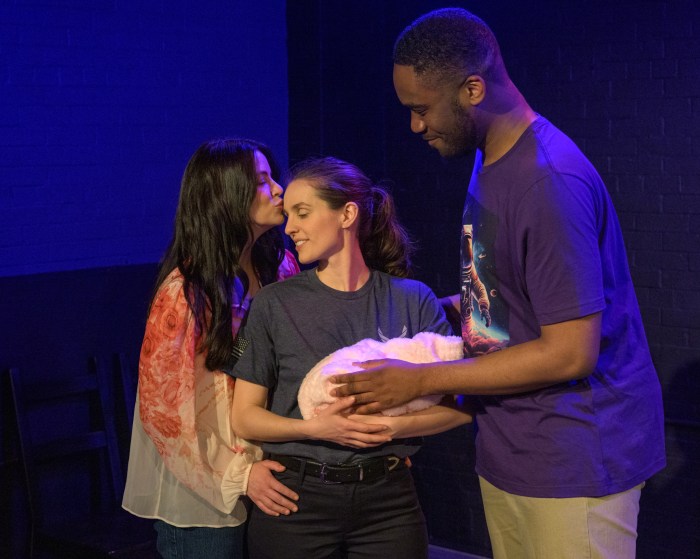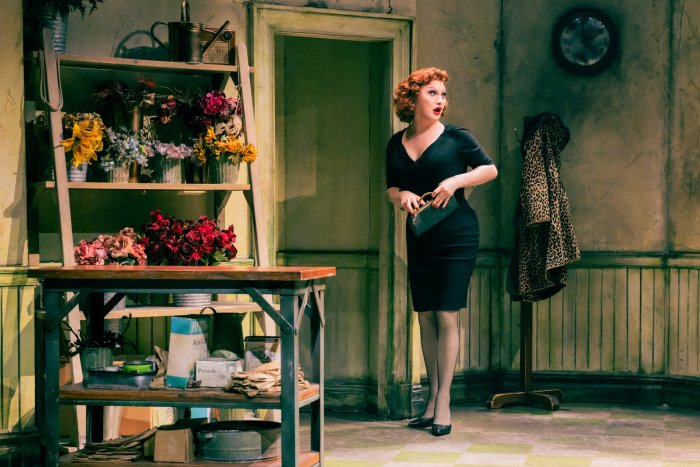Donna Murphy (l.) with Tess Soltau in the Shakespeare in the Park production of “Into the Woods,” running through Sep. 1. | JOAN MARCUS
In its 50th season, Shakespeare in the Park, in a not-so subtle nod to itself, took on two pieces that deal with nature’s transformative power. The journey to the woods is a classic trope of self discovery where, removed from what is familiar, one learns deeper truths about life and love — an apt metaphor for the Public Theater’s annual gift to the city for the past half century. This year, the shimmering “As You Like It” at the beginning of the summer has given way to the darker and more psychologically complex “Into the Woods.”
Under the direction of Timothy Sheader, who originally directed this production in London, the path through this “Woods” is meandering and plagued with wrong turns. From the beginning, Sheader chooses to reframe the production as a child’s dream, adding a stultifying recorded prologue in which the child has run away from home after a fight with his father and finds himself in the woods. He drops his backpack, takes out a collection of toys, and begins to play out the story as it comes to life behind him. The problem, of course, is that the emotional, sexual, and intellectual sophistication in James Lapine’s book is so far beyond the understanding of a child eight years old or so, particularly in the second act when things get out of control, that the device feels like a gimmick.
And, by framing the whole piece as a dream, Sheader undermines what makes this show so inherently bittersweet –– our recognition that life does not go on happily every after, but that we must take life on its own terms, even when tragic, without any magical interventions. The brilliance of “Into the Woods” was not in assuring us that “it’s just a dream,” but rather in employing classic fairy tales to tell us to grow up.
The first act melds “Cinderella,” “Jack and the Beanstalk,” “Little Red Riding Hood,” and the story of a childless Baker and his wife. The storylines cross as the Baker and his wife try to get the Witch to reverse the curse that has left them childless. We arrive at happily ever after by the end of the first act, but second act deconstructs that idea. Cinderella finds being a princess not so wonderful, and Jack faces the consequences of stealing from the giant at the top of the beanstalk. Suddenly, the characters are all thrown together with a common enemy.
At the end of the battle, the essential questions that permeate all of Sondheim’s work remain –– will I be alone and how will I make it through? From “Being Alive” in “Company” to “By the Sea” in “Sweeney Todd” to “Send in the Clowns” in “A Little Night Music,” the nearly desperate longing to have someone to count on is his constant theme. “No One is Alone” at the end of “Into the Woods” would seem to be the answer to all of those other songs, and sung to a child — and a man-child — it is the balm all the characters have sought. For this simple idea to be credible. However, it must come at the end of conflict; it cannot, as Puck says in “A Midsummer Night’s Dream,” be “no more yielding than a dream.” As a dream, there’s nothing at stake for the characters on the journey.
This could be Sheader’s misreading of the show or a desire to pander to a contemporary audience and avoid the existential pain that make this a show for grown-ups. Either way, the production feels facile, cartoonish, and unfocused. If the conflict is ephemeral, there can be no catharsis. If there’s no catharsis, there’s neither acceptance nor healing. When the Witch sings to the Baker at the end, “careful the tale you tell, that is the spell,” it should move us. In this production, it’s a platitude too easily dismissed.
Still, given the material, it’s hard for any production to be a total loss. The sets by John Lee Beatty and Soutra Gilmour are wonderful. There’s a great deal of visual creativity in the puppets by Rachael Canning, especially the expressive cow Milky White.
Donna Murphy as the Witch is sublime. She plays the conflict and the anger beautifully, and she is heart-wrenching when she realizes that she got her wish, but it made her ordinary. Jessie Mueller is a suitably complex Cinderella, with a balance of pluck, vulnerability, and neurosis that’s always interesting. Sarah Stiles is sharp as Little Red Riding Hood. Gideon Glick as Jack is also appealing.
Less successful are Denis O’Hare as the Baker –– he never finds the center of the role and wanders aimlessly most of the night –– and Amy Adams, bland as his wife. Adams’ singing was consistently flat the night I saw it, and she just missed the “can’t miss” “Moments in the Woods,” a powerful meditation after her tryst with the Prince in the woods. Ivan Hernandez as Cinderella’s Prince and the Wolf was out of control, playing for easy laughs, not for anything darker or truer.
In taking us through this “Woods,” director Sheader has misled us, trying to tell us that there is perhaps an easier, softer way to get through. Anyone who has made the journey knows that that is a fairly tale.
INTO THE WOODS | Delacorte Theater, Central Park | Enter at W. 80th St. & Central Pk. W. Aug. 23-25, 27-31, Sep. 1 at 8 p.m. | Free, but tickets required | ShakespeareinthePark.org



































